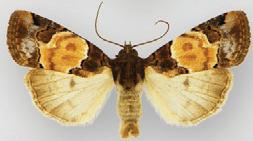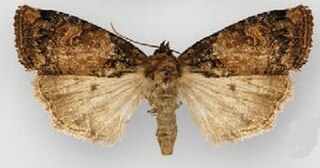
The Noctuidae, commonly known as owlet moths, cutworms or armyworms, are the most controversial family in the superfamily Noctuoidea because many of the clades are constantly changing, along with the other families of the Noctuoidea. It was considered the largest family in Lepidoptera for a long time, but after regrouping Lymantriinae, Catocalinae and Calpinae within the family Erebidae, the latter holds this title now. Currently, Noctuidae is the second largest family in Noctuoidea, with about 1,089 genera and 11,772 species. However, this classification is still contingent, as more changes continue to appear between Noctuidae and Erebidae.
Xestia sincera is a moth in the family Noctuidae. Its wingspan is 36 to 39 millimetres, and it can be found in the Nordic countries.

Bryolymnia is a genus of moths of the family Noctuidae erected by George Hampson in 1908.

Cryphia is a genus of moths of the family Noctuidae. The genus was erected by Jacob Hübner in 1818.

Elaphria is a genus of moths of the family Noctuidae. The genus was erected by Jacob Hübner in 1818.

Bryolymnia viridata is a moth of the family Noctuidae first described by Leon F. Harvey in 1876. It is found in the US in western California from Sonoma County north of San Francisco southward to San Diego County.
Pseudomarimatha is a monotypic moth genus of the family Noctuidae. Its only species, Pseudomarimatha flava, is known from the western United States only in south-eastern Arizona and south-western New Mexico. Both the genus and species were first described by Clifford D. Ferris and J. Donald Lafontaine in 2010.

Bryolymnia viridimedia is a moth of the family Noctuidae first described by John Bernhardt Smith in 1905. It is found from south-eastern Arizona southward in the Sierra Madre Occidental to the Mexico City area.

Bryolymnia marti is a moth of the family Noctuidae first described by Richard Holland in 2010. It is found from central New Mexico and east-central Arizona southward to Durango in northern Mexico.

Bryolymnia mixta is a moth of the family Noctuidae first described by Donald Lafontaine and J. Walsh in 2010. It is known only from the Patagonia Mountains in south-eastern Arizona.

Bryolymnia biformata is a moth of the family Noctuidae first described by Donald Lafontaine and J. Walsh in 2010. It is known only from the Huachuca, Patagonia, and Santa Rita Mountains in south-eastern Arizona.

Bryolymnia anthracitaria is a moth of the family Noctuidae first described by Clifford D. Ferris and Noel McFarland in 2007. It is known only from south-eastern Arizona where it has been collected in oak scrub grassland.

Bryolymnia poasia is a moth of the family Noctuidae first described by William Schaus in 1911. It is found in Costa Rica.

Bryolymnia semifascia, the half-banded bryolymnia, is a moth of the family Noctuidae. The species was first described by John Bernhardt Smith in 1900. It is found in the US from northern Colorado and southern Utah southward to south-eastern Arizona and south-central New Mexico.

Bryolymnia picturata is a moth of the family Noctuidae first described by William Schaus in 1894. It is found in south-eastern Mexico.

Bryolymnia ensina is a moth of the family Noctuidae first described by William Barnes in 1907. It occurs in coniferous forests from south-eastern Arizona and south-western New Mexico southward in the Sierra Madre Occidental to the state of Durango in Mexico.

The Erebidae are a family of moths in the superfamily Noctuoidea. The family is among the largest families of moths by species count and contains a wide variety of well-known macromoth groups. The family includes the underwings (Catocala); litter moths (Herminiinae); tiger, lichen, and wasp moths (Arctiinae); tussock moths (Lymantriinae), including the arctic woolly bear moth ; piercing moths ; micronoctuoid moths (Micronoctuini); snout moths (Hypeninae); and zales, though many of these common names can also refer to moths outside the Erebidae. Some of the erebid moths are called owlets.
Emilio Berio was an Italian entomologist and lawyer.

Lithophane grotei, commonly known as Grote's pinion or Grote's sallow, is a species of moth in the family Noctuidae. It was first described by Riley in 1882 and it is found in North America.

Lacinipolia triplehorni is a species of cutworm in the family Noctuidae. It is found in North America.
This page is based on this
Wikipedia article Text is available under the
CC BY-SA 4.0 license; additional terms may apply.
Images, videos and audio are available under their respective licenses.








